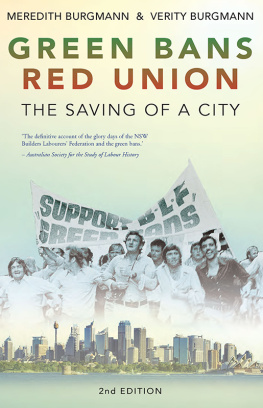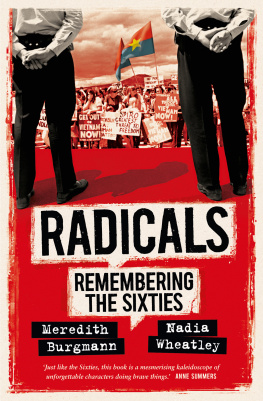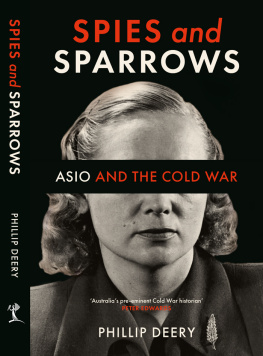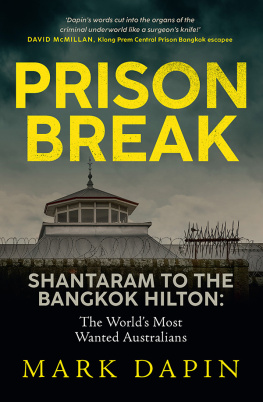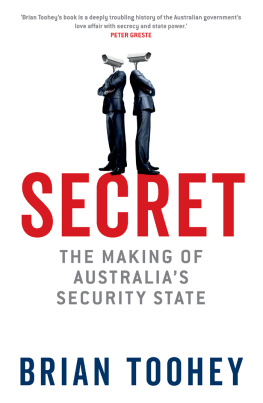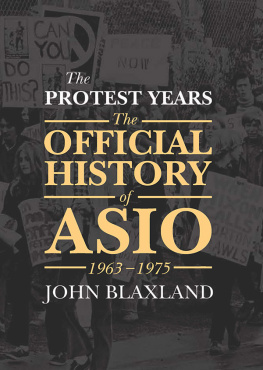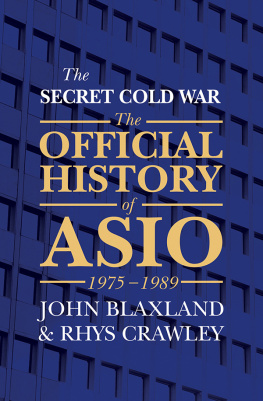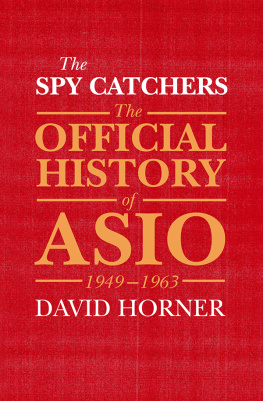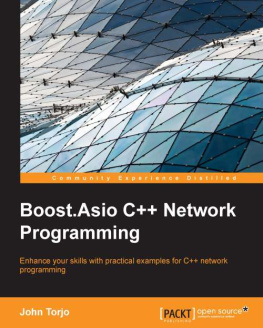DIRTY SECRETS
OUR ASIO FILES
MEREDITH BURGMANN was radicalised at Sydney University by the Vietnam War and was one of the leaders of the anti-apartheid movement, infamously receiving a two-month gaol sentence for disrupting a Springbok rugby match in 1971. She taught industrial relations at Macquarie University for eighteen years and was later a Labor Member of and President of the Legislative Council of New South Wales, retiring in 2007. Until recently she was President of the Australian Council for International Development, the peak body for Australias NGO aid agencies.
Also by Meredith Burgmann:
Green Bans, Red Union: Environmental activism and the NSW Builders Labourers Federation (with Verity Burgmann)
The Ernies Book: 1000 terrible things Australian men have said about women (with Yvette Andrews)
DIRTY SECRETS
OUR ASIO FILES
edited by
MEREDITH BURGMANN

NEWSOUTH
This book is for my comrades who were so steadfast through all those years and still are. I especially remember my co-convenors in the Stop the Tours campaign, Denis Freney and Peter McGregor. It is also for Paddy Batchelor, in the hope that the next generation of political activists dont get spied upon.
A NewSouth book
Published by
NewSouth Publishing
University of New South Wales Press Ltd
University of New South Wales
Sydney New South Wales 2052
AUSTRALIA
This collection and introduction Meredith Burgmann 2014
Individual essays individual contributors 2014
First published 2014
This book is copyright. While copyright of the work as a whole is vested in Meredith Burgmann, copyright of individual chapters is retained by the chapter authors. Apart from any fair dealing for the purpose of private study, research, criticism or review, as permitted under the Copyright Act, no part of this book may be reproduced by any process without written permission. Inquiries should be addressed to the publisher.
National Library of Australia
Cataloguing-in-Publication entry
Title: Dirty secrets: our ASIO files / Meredith Burgmann, editor.
ISBN: 9781742231402 (paperback)
9781742241753 (ePub)
9781742246819 (ePDF)
Subjects: Australian Security Intelligence Organisation Archives.
Australians Archives.
Intelligence service Australia History.
Internal security Australia History 20th century.
Secret service Australia History.
Australia Politics and government 1945
Other Authors/Contributors: Burgmann, Meredith, 1947 editor.
Dewey Number: 327.120994
Design Di Quick
Cover images Mark Aarons, Peter Cundall and Phillip Adams photos: courtesy of ABC; Kevin Cook photo: Penny Tweedie; Peter Murphy photo: Gill Leahy; other photos courtesy of contributors.
All reasonable efforts were taken to obtain permission to use copyright material reproduced in this book, but in some cases copyright could not be traced. The editor welcomes information in this regard.
This project has been assisted by the Australian Government through the Australia Council for the Arts, its arts funding and advisory body.


CONTENTS

I n these days of increased intelligence powers, a ballooning national security budget, a giant new ASIO headquarters in Canberra, and endless discussion about WikiLeaks and the right to know, I wanted to look at the effect of spying on those who have been its targets. David McKnight and others have written extensively about our spy agencies. This book is the stories of those spied upon. There is particular satisfaction in the fact that a group of Australians who have had their lives secretly recorded in detail over many decades are at last getting their own back. We are finally writing about them instead of them writing about us.
I became interested in the early ASIO story when doing my Masters thesis on the Chifley Government and Russia. At one stage I interviewed former Immigration Minister Arthur Calwell and Postwar Reconstruction Minister Jack Dedman, who delighted in giving me gory details about atom bomb secrets, the birth of ASIO, the tumultuous incidents surrounding Sir David Rivett and the Secrecy Act and so on. To read my own extensive file much later was a fitting bookend to this early interest.
In compiling this book I approached almost a hundred people who I thought were likely to have been ASIO targets, and gave them instructions about how to apply for their files. About half were told they did not have files. In some cases this was simply not believable. Nadia Wheatley was told she did not have a file although her arrest record was similar to mine and she was heavily involved in the targeted areas of Aboriginal rights and anti-Vietnam war activity.
Not everyone was keen to see their files. My sister Verity, a historian and one-time Trotskyist, did not want to look at hers in case she found out that someone she knew and liked was an informant. Academic Ann Curthoys was so reluctant to look at hers that in the end she declined to participate. I found myself strangely unable to open my own large parcel for many months. Some were reduced to tears. The writer Roger Milliss wept as he read about the extensive surveillance his father had endured; including twenty pages of intrusive details about his fathers funeral.
During this process I became a bit of an expert on who seemed to attract files and who did not. Being in the Communist Party or a Trotskyist group was an obvious qualification, but some CPA members, strangely, did not have files. Being arrested could trigger a file, but not necessarily. Being involved, however marginally, with Eastern European countries almost always aroused interest, as did having progressive views and being involved with communications systems or scientific research. Any combination of these factors was a likely trigger.
I am indebted to Dr David McKnight who has written the chapter How to Read Your ASIO File for this book. Not only has he set out the meaning of all the various notations and initials scribbled on our files (as the reader will discover, many of us could only guess what the shorthand meant, at the time of writing), but he has reduced his major academic works on ASIO into a useful Cooks Tour of ASIOs history and present context. It was David who pointed out that some of the language in the files, which had seemed so formal and polite to me, was simply public service-ese. The men and women employed by ASIO were public servants unusual public servants, for sure, but they knew how to file and index and write polite notes to their superiors.
Each of the twenty-six chapters is very different from each other. The life experiences of each ASIO target varied greatly, from Col Cooper, a fifteen-year-old telegram boy at the PMG, to Michael Kirby, a civil liberties solicitor; Frank Hardy, a struggling, mostly penniless writer; Anne Summers, a strident early feminist; Gary Foley, an angry young Aboriginal activist; and Joan Bielski, a newly qualified English teacher.
The contributions encompass five decades of political spying, from the early fifties with Clive Evatt, Frank Hardy, Joan Bielski and Michael Kirby, right through to the 1990s when the NSW Special Branch was closed down by the Carr Labor Government and New South Wales activists were granted access to their files.
Next page

